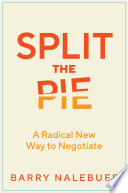

The central metaphor of the book is the 'pie', representing the value created in any negotiation or partnership. The idea is that this pie can be split among the parties involved based on their contributions and the value they bring to the table. Understanding how to assess one’s own contribution and that of others is crucial for fair negotiations. The pie concept emphasizes that value is not fixed but can be expanded through collaboration, creativity, and effective communication. By recognizing the pie's dynamics, parties can work together to create more value than they could alone, leading to better outcomes for everyone involved.
Continue readingThe book distinguishes between two critical aspects of negotiation: value creation and value claiming. Value creation involves working collaboratively to increase the total value available (the pie), while value claiming focuses on how to divide that value once it has been created. Effective negotiators must excel in both areas, understanding when to collaborate and when to assert their claims. This distinction highlights the importance of strategic thinking in negotiations, as parties must navigate the tension between collaboration and competition to achieve their objectives.
Continue readingInformation plays a pivotal role in negotiations, influencing perceptions of value and the distribution of the pie. The book emphasizes the importance of transparency and information sharing among negotiating parties. When parties are open about their needs, interests, and contributions, they can reach more equitable agreements. Conversely, withholding information can lead to misunderstandings and suboptimal outcomes. The author argues that fostering a culture of information sharing can enhance trust and lead to more successful negotiations.
Continue readingNegotiation is portrayed as a process rather than a one-time event. The book outlines the stages of negotiation, including preparation, discussion, and agreement, emphasizing the iterative nature of negotiations. Each stage presents opportunities for learning and adaptation. By viewing negotiation as a process, parties can approach it with a mindset geared toward long-term relationships and ongoing collaboration rather than a zero-sum game. This perspective encourages negotiators to build rapport and seek win-win solutions that can benefit all parties involved.
Continue readingBuilding and maintaining relationships is critical in negotiations. The book discusses how strong relationships can facilitate better communication, trust, and cooperation among parties. When negotiators prioritize relationships, they are more likely to engage in constructive dialogue and explore creative solutions. The author suggests that investing in relationships can lead to more sustainable agreements and opportunities for future collaboration. This idea underscores the human element of negotiation, reminding readers that successful outcomes often depend on the quality of interpersonal interactions.
Continue readingEmotional intelligence (EI) is highlighted as an essential skill for effective negotiation. The book explains how understanding and managing emotions—both one's own and those of others—can significantly impact negotiation outcomes. High EI allows negotiators to navigate conflicts, empathize with others, and maintain composure under pressure. The author provides practical strategies for enhancing emotional intelligence, such as active listening and self-reflection, which can help negotiators respond more effectively to the emotional dynamics of the negotiation process.
Continue readingThe book concludes with a set of practical strategies and techniques for successful negotiation. These include preparation tips, communication skills, and tactics for overcoming common challenges. The author encourages readers to adopt a mindset of curiosity and openness, viewing negotiations as opportunities for learning and growth. By applying these strategies, negotiators can improve their effectiveness and achieve more favorable outcomes in their interactions, whether in business, personal relationships, or other contexts.
Continue reading